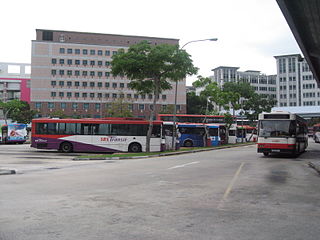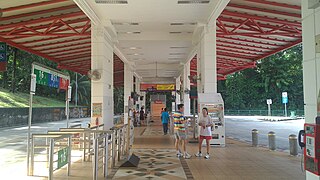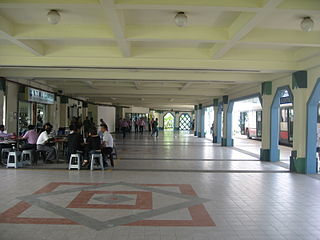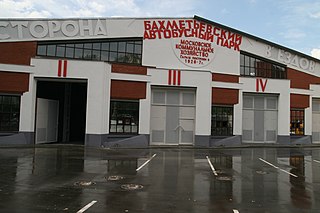
Bus transport forms a significant part of public transport in Singapore, with over 3.9 million rides taken per day on average as of 2016. There are more than 576 scheduled bus services, operated by SBS Transit, SMRT Buses, Tower Transit Singapore and Go-Ahead Singapore. The newest bus operator, Go-Ahead Singapore started operation from 4 September 2016. There are also around 5,400 buses currently in operation.
Rail transport in Singapore mainly consists of a passenger urban rail transit system spanning the entire city-state: a rapid transit system collectively known as the Mass Rapid Transit (MRT) system operated by the two biggest public transport operators SMRT Trains and SBS Transit, as well as several Light Rail Transit (LRT) lines also operated by both companies. In addition, local specialised light rail lines are in operation in places such as the Singapore Changi Airport and Sentosa.

Tampines Bus Interchange is a bus interchange serving Tampines in Singapore. It is an open-air building located in the town centre near the Tampines MRT Station, with the allocated Block 512. There are 29 bus services operating from the bus interchange, making it the 4th busiest bus interchange in Singapore.
Choa Chu Kang Park is a community park in Singapore located beside Kranji Expressway and along Choa Chu Kang Drive.

Sengkang Bus Interchange is a bus interchange located on the ground level of Compass Heights condominium in the town centre of Sengkang New Town, Singapore. Located next to Sengkang MRT/LRT Station, it is the second bus interchange in Singapore to be air conditioned. It was opened on 18 January 2003.

Bukit Panjang Bus Interchange is a bus interchange serving Bukit Panjang New Town, Singapore. It is diagonally opposite Bukit Panjang Plaza and adjacent to Bukit Panjang MRT/LRT Station on the Downtown MRT and Bukit Panjang LRT lines.

Bukit Batok Interchange is an interchange bus station located at Block 631 Bukit Batok Central, Singapore, near West Mall Shopping Centre and Bukit Batok MRT Station. The sheltered concourse is built underneath a multi-storey carpark similar in design to the old Serangoon Interchange.

Bukit Merah Bus Interchange is a bus interchange located in the Bukit Merah Town Centre, along Bukit Merah Central in Bukit Merah, Singapore. The interchange serves the nearby residential estates of Telok Blangah and Bukit Purmei and also the commercial buildings in Bukit Merah Central. It is one of the last surviving bus interchange in Singapore that does not have a direct link to an MRT Station. However, several services link commuters to nearby MRT stations from the interchange. Services 5, 16 and 851 link the interchange to Tiong Bahru, Service 132 links to Redhill, while Service 176 links to Telok Blangah.

Choa Chu Kang Bus Interchange is an bus interchange which mainly serves the residential neighbourhood of Choa Chu Kang. It is located at Choa Chu Kang Loop and connected to Choa Chu Kang MRT/LRT Station and the Lot One Shoppers' Mall. Opened in 1990, the old bus interchange was one of the oldest surviving bus interchanges in Singapore to remain intact from re-modification while still in service for 28 years till 15 December 2018.
Lim Chu Kang Bus Terminal is a bus terminal located at the end of Lim Chu Kang Road. Service 975 loops at the terminal from Bukit Panjang Bus Interchange. This terminal serves the people working in Lim Chu Kang. As of today, the bus terminal has been converted to a bus stop named Police Coast Guard.
Bukit Batok Bus Depot is a bus depot located in Bukit Batok, Singapore.
Woodlands Bus Depot is an SMRT Buses bus depot located in Woodlands, Singapore.
Bedok North Bus Depot is an SBS Transit East District bus depot located in Bedok, Singapore. As of April 2019, the total fleet is 601 buses.

Sungei Kadut is an industrial estate and planning area located in the North Region of Singapore. It is bounded by Bukit Panjang and Choa Chu Kang to the south, Mandai to the east, as well as Lim Chu Kang and the Western Water Catchment to the west. Its northern boundary is defined by the Straits of Johor.

The Larkin Sentral is a bus terminal located in Johor Bahru, Johor, Malaysia. It has direct bus services to and from many cities and towns in Peninsular Malaysia, Singapore and Hat Yai in Thailand. This T-shaped terminal has three levels and about 50 bus bays.

Go-Ahead Singapore is a new Singapore bus operator that commenced operations on 4 September 2016. It is a subsidiary of the Go-Ahead Group.

The Bus Contracting Model (BCM), formerly known as the Government Contracting Model, is a contracting model introduced by the Land Transport Authority in 2014 for public buses in Singapore, implemented in 2016. The BCM is based on the Transperth model in Perth, Western Australia with quality incentive elements from London Buses. Under the BCM, local and overseas bus operators bid for contracts to operate public bus services on behalf of LTA. The LTA has also adopted a new unified lush green livery and logo for all buses, and now procures and owns the bus fleet for all public bus services in Singapore.

The Kranji Marshes is a nature reserve in the northwest area of Singapore. A freshwater marshland, derived from the damming of the Kranji River to form the Kranji Reservoir, became seen as an important habitat. Nature Society Singapore (NSS) drafted a proposal highlighting its conservation value in 1990. This was accepted and included in the government Singapore Green Plan 1993. The 54-hectare site includes woodland and wetlands. NSS adopted the stretch of wetlands in 2008 and supported by sponsorship carried out a restoration program in cooperation with PUB and NParks. It was in 2005 that the area was recategorised as a park and named "Kranji Marshes Park". The parkland was opened to the public in 2016. The area is home to a number of endangered birds, and at least 170 species have been recorded.














